As Battle Harbour is an island, the MV Trinity Pride takes you from the mainland at Mary's Harbour to the wharf at Battle Harbour.
The Grenfell Shed and Wharf in Mary's Harbour was built around 1930. With its simple construction techniques and designs, it is a style once common in southeastern Labrador. The shed is clad in narrow wooden clapboard and sits on wooden posts while the wharf has a plank and log deck and is supported with wooden cribbing and posts. Build to withstand harsh weather, the Grenfell Shed and Wharf is a testament to the skill of its builders.
Leaving Mary's Harbour behind...
and heading back out into the Atlantic Ocean
The mercantile saltfish premises of Battle Harbour were established by a British firm, John Slade and Company in the early 1700s. Because of its location, Battle Harbour became the major base for the region's cod and seal fisheries and for commercial trade. The local population increased rapidly after 1820 when Newfoundland fishing schooners adopted Battle Harbour as their primary port of call and made it the recognized capital of the Labrador floater fishery. For two centuries, Battle Harbour was known unofficially as the capital of Labrador. The first provincial hospital, outside of the capital of St. John's, was established here in 1893 by Dr. Grenfell and it was also the site from which Commander Robert Peary announced his successful expedition to the North Pole in 1909. Noted ecclesiastical architect William Grey designed the Church of St. James the Apostle for Battle Harbour in the late 1840s. Built in 1852 and restored in 1991, St. James is the sole surviving example of Grey's work. It is also the oldest surviving Anglican church in Labrador and the oldest non-Moravian church.
The waterfront was the setting of much bustle and activity. It was used for the landing of marine resources harvested by local fishers, the processing of cod, salmon, seals and herring, the production of barrels, the packaging of fish products, the mending of nets and the production of saltfish. The flake, or fish drying platform at Battle Harbour was the biggest such structure in all of Labrador. The Salt Store, the area's main warehouse for the salt used in the processing of several species, could hold up to 1500 tons. The reconstructed waterfront buildings are reminiscent of an era now past but retain the history of years gone by and they also house an impressive collection of fishery-related artifacts.
The ocean vistas and craggy rock outcrops are a dramatic backdrop for the wooden church and houses that dot the landscape.
The relocation of community residents under a government-sponsored resettlement program from 1965 to 1970 to nearby Mary's Harbour, the replacement of saltfish operations with fresh and frozen fish industries and then the decline in the inshore fishery at the start of the 1990s brought an end to all operations at Battle Harbour. The site was turned over to the Battle Harbour Historic Trust and years of research and architectural restoration has revived the former glory of Battle Harbour. Numerous historic structures, walkways and work areas have been restored or reinstated, and a collection of more than 300 artifacts related to the fishery and everyday life are on display. Accommodations at Battle Harbour are beautifully restored, providing an ambiance of historical charm that is well blended with traditional Labrador hospitality.
Long the social and economic capital of Labrador, Battle Harbour has been polished by the centuries. Beautiful historic building in a context of wild nature make this one of the most restorative, off-the-grid retreats.
Now I think I'll just turn things over to some photos:
My first glimpse of Battle Harbour
Seal Store
Nelson now works for the Historic Trust and grew up on Battle Island
Nelson in the Salt Store
Once providing accommodation for resident managers, explorers and agents, the Battle Harbour Inn, scenically located on a hill is where I stayed
St. James the Apostle
This is the original organ - and it still works
The baptismal font
Site of a plane crash
The "new" cemetery, one of two on Battle Island
The view out one of my bedroom windows
And the view out the other window
The Pork Store building
Inside the Pork Store building
The wagons used for transporting the salt from the wharf up to the salt store building
The RCMP station
This is the site of Battle Harbour's wireless station, erected in 1904 by the Canadian Marconi Wireless Company. It was the first of a series of nine wireless stations located north of Belle Isle. The Battle Harbour station acted as a 'feeder' or collector station for all other coastal Labrador installations. All messages destined north or south were transmitted via the Battle Harbour wireless.
In 1909, the Battle Harbour Marconi station was the focus of international attention when American polar explorer, Robert E. Peary, relied on the station for wireless service to the United States. Peary transmitted the first, exclusive and detailed account of his 1908-1909 Arctic expedition.
The "old" cemetery site
The Salt Store building
Bringing needed materials to Battle Harbour for all the restoration work
Sadly, time to say good-bye
An area above the General Store is known as "The Loft" and is open in the evenings as place for people staying overnight to go and relax and meet each other. I completely lucked out on one of the nights I was there, and was treated to nearly two hours of spontaneous entertainment by Terrance and our boat captain, Harold.
Because I was there for more than just one day/night, I had a chance to do some hiking on Caribou Island which is directly across the tickle from Battle Harbour. On Caribou Island I hiked across the island and over to Matthew's Cove, a little community that is now virtually deserted but once held several residences for families who were resettled to the mainland in the 1960s.
Looking across the tickle to Battle Harbour
Looking down on Matty's (Matthew's) Cove
In one building where the windows weren't boarded up you could see all the remains before the family left for the last time.
This headland is Cape St. Charles - the easternmost point of continental North America
The, mostly abandoned, community of Cape St. Charles
The old church at Cape St. Charles
An old, one-room school house - the one the captain of the boat I was on went to for a little while when he was young
"I'm turning on the air conditioning", said Captain Harold as we were cruising
Looking at Matty's Cove - but this time from the water
Coming back to Battle Harbour









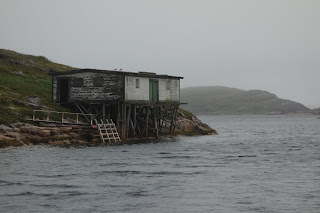























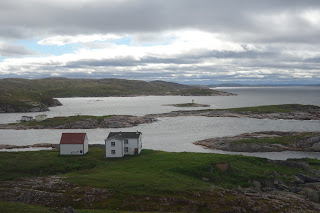




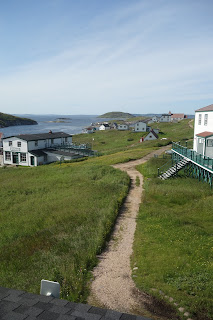



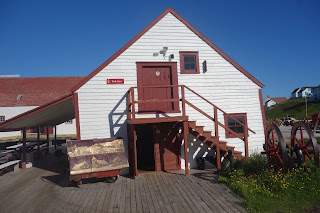
























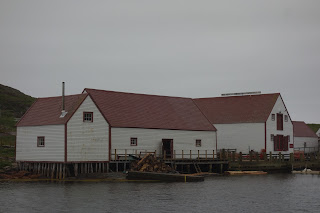










































No comments:
Post a Comment